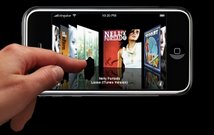The problem is, if applications aren't easy to use, they won't have a future. The phone only has a limited amount of memory. In addition, too many unused applications will only make the phone harder to get around. "Novelty increases people's tolerance for unusable things," says Dave Yeats, a senior research scientist at Perceptive. "As they use it and the novelty wears off, some of these usability problems will start to be more irritating."
Even when an iPhone has the capability to do something, some applications tap that feature better than others--a situation that can vex some users. For instance, some applications are tuned to be exquisitely sensitive to the phone's accelerometer. Tilt the phone just a hair in some applications and a game character, for example, might go flying off the screen. Other applications, such as a free game called "Tilt Snake," aren't sensitive enough. "You had to almost hold your phone upside down and shake it to get the snake to turn," Yeats says.
The iPhone's original applications typically relied on the same cues for navigating through a program. Not so with the hundreds of newbie apps. "Things that were typically on the top would go to the bottom," Thornton says. "Now there is more variation out there."
Shortcuts are another thing Apple does well. For example, when a user pulls up the keyboard to type in a URL on their gadget, it includes a button marked ".com" that saves them four taps. "They just put themselves in the users' shoes to think about what the user is doing at a particular moment," Yeats says.
The solution, according to Thornton, is to study the applications Apple has crafted for the phone and to copy their structure. One of Apple's best tricks, Thornton says, is to use visual cues to help users figure out what to do next. For example, when a phone goes into sleep mode, an animated slider bar draws users' attention to what they have to do to wake the phone up.
"It's a simple thing like letting your user know where they are at all times," says Yeats. "When your screen is so small, you have to let users know where they are at all times."
And if you're lost on how to help your users find their way, just crack open one of Apple's applications and see how it does it.
Monday, September 1, 2008
How To Build A Great iPhone App - Forbes.com
Posted by
About Us
at
3:39 PM
![]()
Subscribe to:
Post Comments (Atom)





No comments:
Post a Comment